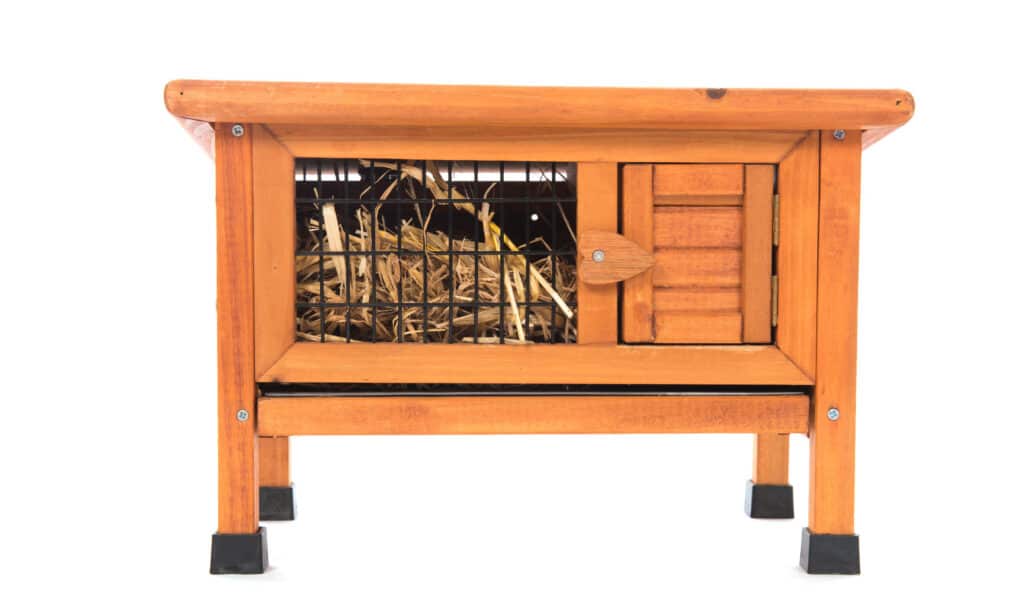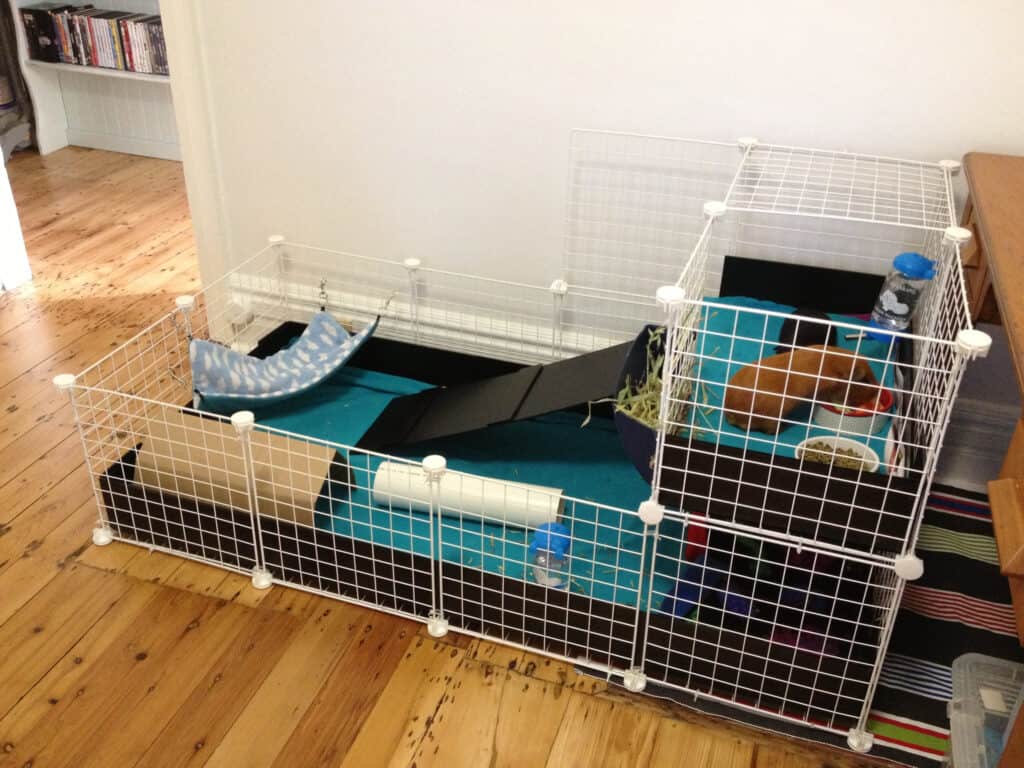Guinea pigs are household favorite pets in many countries, including the United States! In other countries, such as Peru and Bolivia, they may be a common snack. If you decide to keep one as a pet away from the dinner table, there are a number of things you must consider. One important factor is how to make the best possible home for your guinea pig. More specifically, you may wonder which hutch or cage you should get and what size it needs to be. This article will break down everything you need to know to find the right size cage for your guinea pigs!
Importance of Cage Size

The health of your guinea pig can be affected by the cage size.
©iStock.com/Tatiana Terekhina
The cage size is an extremely important factor that impacts a pet guinea pig’s health. Overall size and shape of their cage can affect the animal’s ability to exercise, nest, go to the bathroom, and feed. If a guinea pig is sedentary, meaning if it does not move around enough, there are many potential health consequences including muscle atrophy and organ failure. Generally, pets of all kinds that exercise more live longer than those that cannot exercise enough.
Many hamsters and mice have enclosures that are very tall and contain structures for the animal to climb up or tubes to tunnel through. Guinea pigs, however, are not very good climbers. They require an enclosure that has a sufficient usable area on one level because they cannot easily climb to higher levels. This means that an ideal guinea pig cage is not very tall and is instead larger on the horizontal plane.
Hutch vs. Cage

A hutch is a better option if you choose to keep your guinea pig outside.
©Ivonne Wierink/Shutterstock.com
There are pros and cons to getting a hutch or getting a cage for your guinea pig. One consideration is if you want to keep the guinea pig outside or inside. Typically, if you choose to keep your pet outside then a hutch is the better option. Some wire cages are not made of rust-resistant metal and could get damaged outside. A hutch also provides more protection for the guinea pig from the elements. The sturdy wooden walls and potentially rain proof roof would be more effective against stormy weather than a wire cage. The hutch would also ensure that the guinea pig’s hay and bedding stay dry outside.
Another consideration when choosing between a hutch and a cage is cost. Unfortunately, hutches for guinea pigs, rabbits, and other pets tend to be more expensive than typical cages. The cheaper end of the scale for new cages is about $60. That is a cage of the minimum appropriate size. Hutches start around a whopping $130, and some very nice ones go for $550 or more! To be fair, hutches are typically of higher quality and are likely to last longer than a cheaper cage. Nevertheless, the price difference is considerable.
Types of Cages

©Phil Whitehouse / flickr – License
If you do decide on a cage for your guinea pig, there are different types to choose from. A very popular and often recommended option is a C&C cage. C&C stands for cubes and coroplast. Coroplast is a type of corrugated plastic that serves as the floor of the guinea pig cage. The walls of the cage are most often steel wire frames that lock together. The steel grid of the frame is what inspires the “cubes” term in the C&C cage’s name. Many local humane societies or rescue organizations recommend the C&C cage for pet guinea pigs.
There are some types of cages that absolutely must be avoided for the safety of your guinea pig. These include cages with wire frame floors, enclosures with plastic tube pathways, plastic bins, glass aquariums, and sealed containers. Guinea pig housing with wire floors can injure the animals and even cause serious fractures. Similarly, other materials like glass or plastic containers can be dangerous. Since guinea pigs are not proficient climbers and because they are larger than other rodent pets, plastic tubes can be hazardous to them as well.
Cage Size Recommendations: By The Numbers
The size of the cage a guinea pig is living in has great consequences to its physical health and is also important to its mental well-being. Guinea pigs are social creatures, just like humans. Pet owners often get two or more guinea pigs together so one isn’t lonely. More guinea pigs, however, means you’ll need a larger enclosure!
By the numbers, there are set minimum recommendations for cage size relative to the number of guinea pigs. For one guinea pig, the cage must be at least 30” by 36”, or about 7.5 square feet. With two guinea pigs, the minimum area requirement is 30” by 50” or about 10.5 square feet. For three guinea pigs, 30” by 62” (13 square feet) and for four, 30” by 76” (15.8 square feet).
With any number of guinea pigs, the enclosure must either not have a top or must be a minimum of one foot high. If the guinea pig enclosure is inside or is otherwise protected from the weather, an open-top cage is preferable. Guinea pigs are not known to escape frequently if an enclosure does not have a top. They are timid and often hesitate at opportunities to escape. Not being able to climb or jump would also make their escape unlikely.
In summary:
| Number of Guinea Pigs | Minimum Cage Dimensions (in) | Approx. Minimum Cage Area (ft sq) |
|---|---|---|
| 1 | 30” x 36” | 7.5 |
| 2 | 30” x 50” | 10.5 |
| 3 | 30” x 62” | 13 |
| 4 | 30” x 76” | 15.5 |
More Information
For more information on the requirements and recommendations for guinea pig cages, check out these resources. You can contact or search online your local humane society. Also, rescue shelters often have requirements before they will allow someone to adopt an animal. Shelters can provide information as to what the minimum standards are for your pet’s home. You can also get additional information about the importance of having sufficient space, getting enough exercise, and being in a large cage from your local vet. Understanding the health impacts of an animal’s living arrangement is very important when selecting a cage.
Articles Next Up:
- Male Guinea Pigs vs Female Guinea Pigs: What’s the Difference?
- Discover Hairless Guinea Pigs: Skinny Pigs and Baldwin Guinea
- Best Vegetables to Feed Guinea Pigs
- Guinea Pig Names: Boy and Girl Names for Your Guinea Pig
- Pregnant Guinea Pigs: How to Tell if Your Guinea Pig is Pregnant
The photo featured at the top of this post is © iStock.com/Tatiana Terekhina
Thank you for reading! Have some feedback for us? Contact the AZ Animals editorial team.






